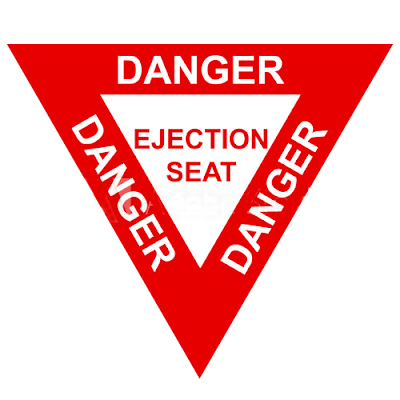Markings are placed on aircraft surfaces to provide servicing instructions, fuel and oil specifications, tank capacities, and to identify lifting and leveling points, walkways, battery locations, or any areas that should be identified. These markings can be applied by stenciling or by using decals.
Decals are used instead of painted instructions because they are usually less expensive and easier to apply. Decals used on aircraft are usually of three types:
Decals are used instead of painted instructions because they are usually less expensive and easier to apply. Decals used on aircraft are usually of three types:
- Paper
- Metal
- Vinyl film.
These decals are suitable for exterior and interior surface application.
Place one edge of the decal on the prepared receiving surface and press lightly, then slide the paper backing from beneath the decal. Perform any minor alignment with the fingers. Remove water by gently blotting the decal and adjacent area with a soft, absorbent cloth. Remove air or water bubbles trapped under the decal by wiping carefully toward the nearest edge of the decal with a cloth. Allow the decal to dry.
Remove metal decals by moistening the edge of the foil with aliphatic naphtha and peeling the decal from the adhering surface. Work in a well-ventilated area.
Vinyl film decals are removed by placing a cloth saturated with MEK on the decal and scraping with a plastic scraper. Remove the remaining adhesive by wiping with a cloth dampened with a dry-cleaning solvent.
RELATED POSTS
To assure proper adhesion of decals, clean all surfaces thoroughly with aliphatic naphtha to remove grease, oil, wax, or foreign matter. Porous surfaces should be sealed and rough surfaces sanded, followed by cleaning to remove any residue.
The instructions to be followed for applying decals are usually printed on the reverse side of each decal. A general application procedure for each type of decal is presented in the following paragraphs to provide familiarization with the techniques involved.
The instructions to be followed for applying decals are usually printed on the reverse side of each decal. A general application procedure for each type of decal is presented in the following paragraphs to provide familiarization with the techniques involved.
Paper Decals
Immerse paper decals in clean water for 1 to 3 minutes. Allowing decals to soak longer than 3 minutes causes the backing to separate from the decal while immersed. If decals are allowed to soak less than 1 minute, the backing does not separate from the decal.Place one edge of the decal on the prepared receiving surface and press lightly, then slide the paper backing from beneath the decal. Perform any minor alignment with the fingers. Remove water by gently blotting the decal and adjacent area with a soft, absorbent cloth. Remove air or water bubbles trapped under the decal by wiping carefully toward the nearest edge of the decal with a cloth. Allow the decal to dry.
Metal Decals with Cellophane Backing
Apply metal decals with cellophane backing adhesive as follows:- Immerse the decal in clean, warm water for 1 to 3 minutes.
- Remove it from the water and dry carefully with a clean cloth.
- Remove the cellophane backing, but do not touch adhesive.
- Position one edge of the decal on the prepared receiving surface. On large foil decals, place the center on the receiving surface and work outward from the center to the edges.
- Remove all air pockets by rolling firmly with a rubber roller, and press all edges tightly against the receiving surface to ensure good adhesion.
Metal Decals With Paper Backing
Metal decals with a paper backing are applied similarly to those having a cellophane backing. However, it is not necessary to immerse the decal in water to remove the backing. It may be peeled from the decal without moistening. Follow the manufacturer’s recommendation for activation of the adhesive, if necessary, before application. The decal should be positioned and smoothed out following the procedures given for cellophane-backed decals.Metal Decals with No Adhesive
Apply decals with no adhesive in the following manner:- Apply one coat of cement, Military Specification MIL-A-5092, to the decal and prepared receiving surface.
- Allow cement to dry until both surfaces are tacky.
- Apply the decal and smooth it down to remove air pockets.
- Remove excess adhesive with a cloth dampened with aliphatic naphtha.
Vinyl Film Decals
To apply vinyl film decals, separate the paper backing from the plastic film. Remove any paper backing adhering to the adhesive by rubbing the area gently with a clean cloth saturated with water. Remove small pieces of remaining paper with masking tape.- Place vinyl film, adhesive side up, on a clean porous surface, such as wood or blotter paper.
- Apply recommended activator to the adhesive in firm, even strokes to the adhesive side of decal.
- Position the decal in the proper location, while adhesive is still tacky, with only one edge contacting the prepared surface.
- Work a roller across the decal with overlapping strokes until all air bubbles are removed.
Removal of Decals
Paper decals can be removed by rubbing the decal with a cloth dampened with lacquer thinner. If the decals are applied over painted or doped surfaces, use lacquer thinner sparingly to prevent removing the paint or dope.Remove metal decals by moistening the edge of the foil with aliphatic naphtha and peeling the decal from the adhering surface. Work in a well-ventilated area.
Vinyl film decals are removed by placing a cloth saturated with MEK on the decal and scraping with a plastic scraper. Remove the remaining adhesive by wiping with a cloth dampened with a dry-cleaning solvent.
RELATED POSTS

